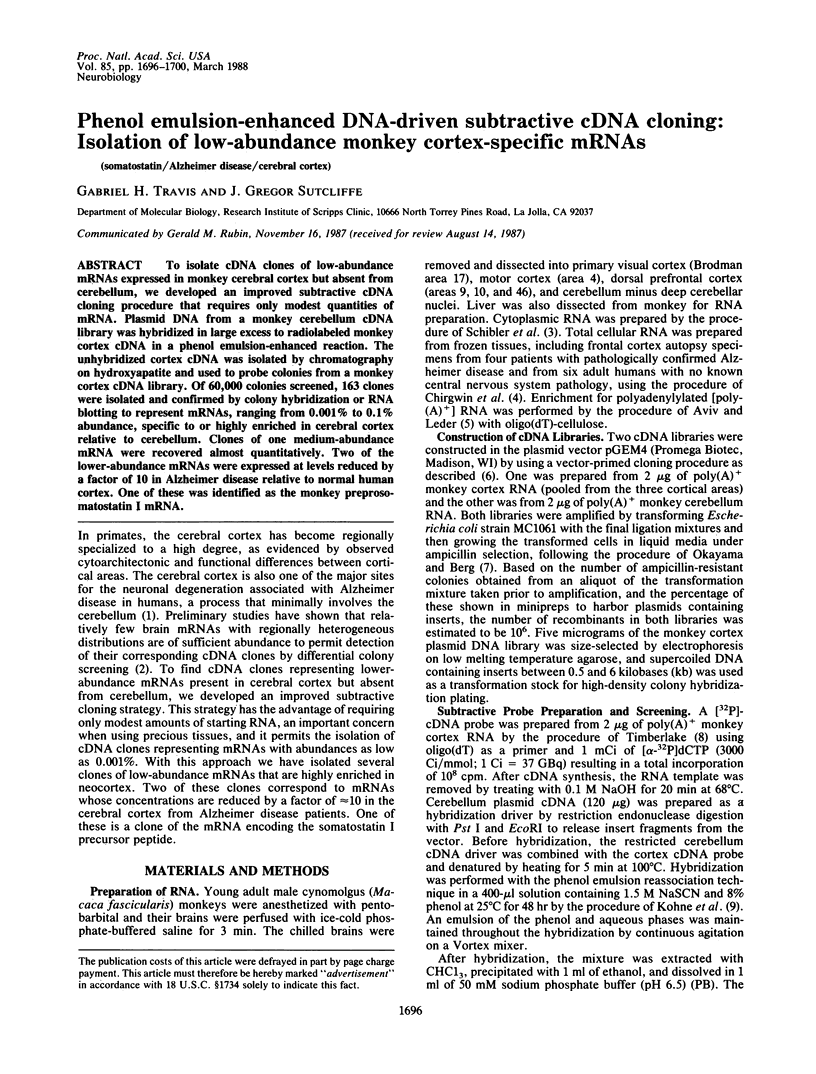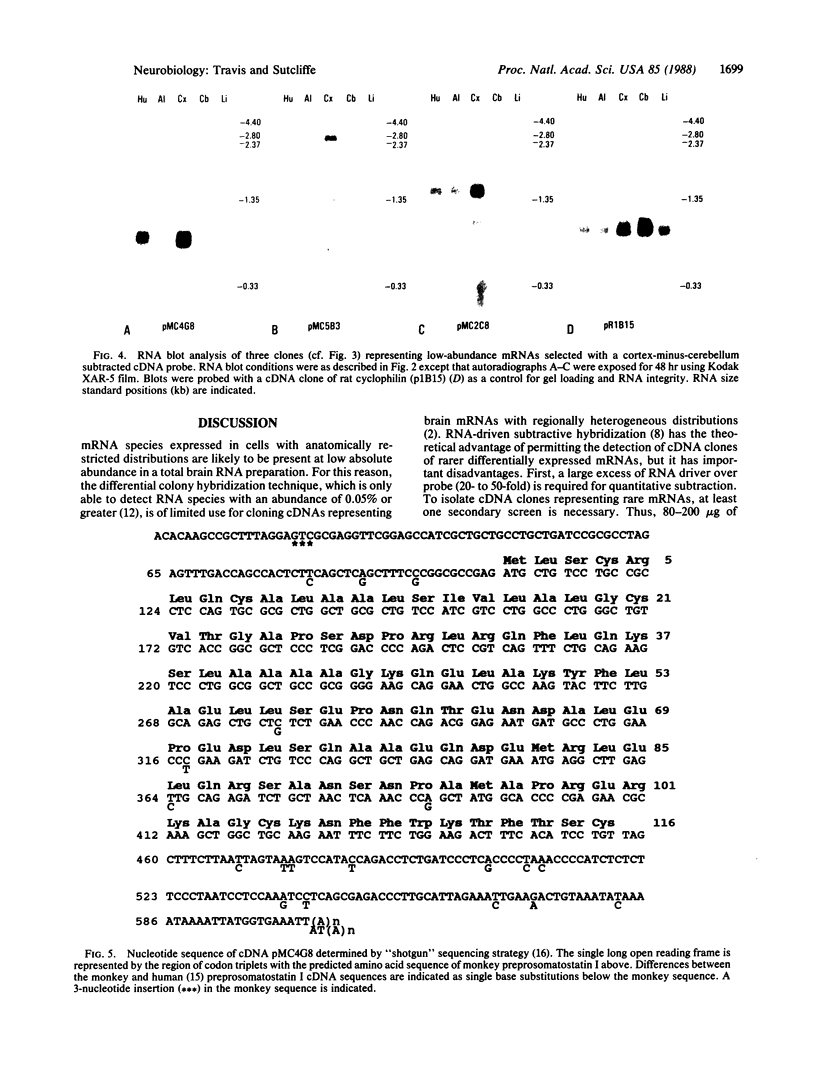Abstract
To isolate cDNA clones of low-abundance mRNAs expressed in monkey cerebral cortex but absent from cerebellum, we developed an improved subtractive cDNA cloning procedure that requires only modest quantities of mRNA. Plasmid DNA from a monkey cerebellum cDNA library was hybridized in large excess to radiolabeled monkey cortex cDNA in a phenol emulsion-enhanced reaction. The unhybridized cortex cDNA was isolated by chromatography on hydroxyapatite and used to probe colonies from a monkey cortex cDNA library. Of 60,000 colonies screened, 163 clones were isolated and confirmed by colony hybridization or RNA blotting to represent mRNAs, ranging from 0.001% to 0.1% abundance, specific to or highly enriched in cerebral cortex relative to cerebellum. Clones of one medium-abundance mRNA were recovered almost quantitatively. Two of the lower-abundance mRNAs were expressed at levels reduced by a factor of 10 in Alzheimer disease relative to normal human cortex. One of these was identified as the monkey preprosomatostatin I mRNA.
Full text
PDF




Images in this article
Selected References
These references are in PubMed. This may not be the complete list of references from this article.
- Aviv H., Leder P. Purification of biologically active globin messenger RNA by chromatography on oligothymidylic acid-cellulose. Proc Natl Acad Sci U S A. 1972 Jun;69(6):1408–1412. doi: 10.1073/pnas.69.6.1408. [DOI] [PMC free article] [PubMed] [Google Scholar]
- Chirgwin J. M., Przybyla A. E., MacDonald R. J., Rutter W. J. Isolation of biologically active ribonucleic acid from sources enriched in ribonuclease. Biochemistry. 1979 Nov 27;18(24):5294–5299. doi: 10.1021/bi00591a005. [DOI] [PubMed] [Google Scholar]
- Davies P., Katzman R., Terry R. D. Reduced somatostatin-like immunoreactivity in cerebral cortex from cases of Alzheimer disease and Alzheimer senile dementa. Nature. 1980 Nov 20;288(5788):279–280. doi: 10.1038/288279a0. [DOI] [PubMed] [Google Scholar]
- Dworkin M. B., Dawid I. B. Use of a cloned library for the study of abundant poly(A)+RNA during Xenopus laevis development. Dev Biol. 1980 May;76(2):449–464. doi: 10.1016/0012-1606(80)90393-0. [DOI] [PubMed] [Google Scholar]
- Feinberg A. P., Vogelstein B. A technique for radiolabeling DNA restriction endonuclease fragments to high specific activity. Anal Biochem. 1983 Jul 1;132(1):6–13. doi: 10.1016/0003-2697(83)90418-9. [DOI] [PubMed] [Google Scholar]
- Gergen J. P., Stern R. H., Wensink P. C. Filter replicas and permanent collections of recombinant DNA plasmids. Nucleic Acids Res. 1979 Dec 20;7(8):2115–2136. doi: 10.1093/nar/7.8.2115. [DOI] [PMC free article] [PubMed] [Google Scholar]
- Grunstein M., Wallis J. Colony hybridization. Methods Enzymol. 1979;68:379–389. doi: 10.1016/0076-6879(79)68027-8. [DOI] [PubMed] [Google Scholar]
- Kohne D. E., Levison S. A., Byers M. J. Room temperature method for increasing the rate of DNA reassociation by many thousandfold: the phenol emulsion reassociation technique. Biochemistry. 1977 Nov 29;16(24):5329–5341. doi: 10.1021/bi00643a026. [DOI] [PubMed] [Google Scholar]
- Milner R. J., Lai C., Nave K. A., Lenoir D., Ogata J., Sutcliffe J. G. Nucleotide sequences of two mRNAs for rat brain myelin proteolipid protein. Cell. 1985 Oct;42(3):931–939. doi: 10.1016/0092-8674(85)90289-2. [DOI] [PubMed] [Google Scholar]
- Morrison J. H., Rogers J., Scherr S., Benoit R., Bloom F. E. Somatostatin immunoreactivity in neuritic plaques of Alzheimer's patients. Nature. 1985 Mar 7;314(6006):90–92. doi: 10.1038/314090a0. [DOI] [PubMed] [Google Scholar]
- Okayama H., Berg P. A cDNA cloning vector that permits expression of cDNA inserts in mammalian cells. Mol Cell Biol. 1983 Feb;3(2):280–289. doi: 10.1128/mcb.3.2.280. [DOI] [PMC free article] [PubMed] [Google Scholar]
- Roberts G. W., Crow T. J., Polak J. M. Location of neuronal tangles in somatostatin neurones in Alzheimer's disease. Nature. 1985 Mar 7;314(6006):92–94. doi: 10.1038/314092a0. [DOI] [PubMed] [Google Scholar]
- Schibler U., Tosi M., Pittet A. C., Fabiani L., Wellauer P. K. Tissue-specific expression of mouse alpha-amylase genes. J Mol Biol. 1980 Sep 5;142(1):93–116. doi: 10.1016/0022-2836(80)90208-9. [DOI] [PubMed] [Google Scholar]
- Shen L. P., Pictet R. L., Rutter W. J. Human somatostatin I: sequence of the cDNA. Proc Natl Acad Sci U S A. 1982 Aug;79(15):4575–4579. doi: 10.1073/pnas.79.15.4575. [DOI] [PMC free article] [PubMed] [Google Scholar]
- Timberlake W. E. Developmental gene regulation in Aspergillus nidulans. Dev Biol. 1980 Aug;78(2):497–510. doi: 10.1016/0012-1606(80)90349-8. [DOI] [PubMed] [Google Scholar]
- Travis G. H., Naus C. G., Morrison J. H., Bloom F. E., Sutcliffe J. G. Subtractive cloning of complementary DNAs and analysis of messenger RNAs with regional heterogeneous distributions in primate cortex. Neuropharmacology. 1987 Jul;26(7B):845–854. doi: 10.1016/0028-3908(87)90061-x. [DOI] [PubMed] [Google Scholar]
- Tsou A. P., Lai C., Danielson P., Noonan D. J., Sutcliffe J. G. Structural characterization of a heterogeneous family of rat brain mRNAs. Mol Cell Biol. 1986 Mar;6(3):768–778. doi: 10.1128/mcb.6.3.768. [DOI] [PMC free article] [PubMed] [Google Scholar]






